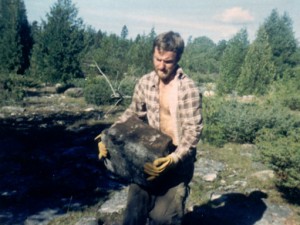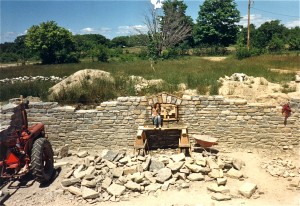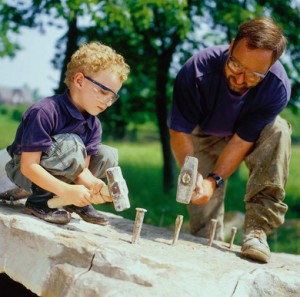 In 1986 I bought an empty piece of farmland and forest in a quiet corner of rural Canada and began building a full-time country life for myself. I had a clean slate to create whatever house, gardens, water systems and outbuildings I wanted, and the adventure of designing and creating these things with my own hands has become my life’s work. And while I’m thankful for the successes, it’s also easy to see some of the things I should have done differently. So let me pass on a few pieces of wisdom borne from hands-on experience. They’ll save you time and money, and help achieve better success if you have the same dreams I do.
In 1986 I bought an empty piece of farmland and forest in a quiet corner of rural Canada and began building a full-time country life for myself. I had a clean slate to create whatever house, gardens, water systems and outbuildings I wanted, and the adventure of designing and creating these things with my own hands has become my life’s work. And while I’m thankful for the successes, it’s also easy to see some of the things I should have done differently. So let me pass on a few pieces of wisdom borne from hands-on experience. They’ll save you time and money, and help achieve better success if you have the same dreams I do.
Design and Building
If I could change just one thing about the house I built, it would be the east-west orientation of the rooms. As it is now, all the bedrooms are on the west side, with kitchen and living room facing east. This setup works fine, but since designing the floor plan I’ve come to realize how nice it is to wake up to the morning sun. And I’m not the only one who understands this, either. The classic design book “A Pattern Language” lists “sleeping to the east” as one of the 253 archetypal design patterns that makes the built environment attractive and inviting across cultures and situations. This design feature is timeless for a reason.
 Now that my kids are starting to grow up, they’re interested in building homes for themselves on the same property where they grew up. And if I’m lucky enough to actually live next to my grand kids, we’ll be building all our new houses with structural insulated panels. Often called SIPs for short, I dearly wish I’d built my house with this material, too. I know from subsequent experience with SIPs, and seeing how the structures perform in all seasons afterwards, that this system is amazingly energy-efficient, astonishingly strong, plus bat, squirrel and mouse proof.
Now that my kids are starting to grow up, they’re interested in building homes for themselves on the same property where they grew up. And if I’m lucky enough to actually live next to my grand kids, we’ll be building all our new houses with structural insulated panels. Often called SIPs for short, I dearly wish I’d built my house with this material, too. I know from subsequent experience with SIPs, and seeing how the structures perform in all seasons afterwards, that this system is amazingly energy-efficient, astonishingly strong, plus bat, squirrel and mouse proof.
The windows I installed originally are all wood, both inside and out. They look great, but the outside surfaces need regular maintenance, and that’s a lot of work. If I were choosing windows again, I’d pay the extra money for aluminum-clad wood windows. You get the warmth and good looks of wood, without the outdoor refinishing obligation. Also, the best windows are performance certified by an organization — the National Window Wise Certification Program (800-813-9616).
Heat, Water and Power
Another change I’d make is to heat with an outdoor wood burning furnace connected to radiant hydronic heating pipes in the floor. In fact, I have made that change. We now have an outdoor boiler. Cleaner burning outdoor furnaces make this option environmentally responsible these days, and it’s also a labor-saving feature, too. After cutting, splitting and stacking 20 years worth of ordinary stovewood, I know quite well that you’ll save lots of effort if you can cut your wood big and store it under cover right next to the place you’ll be burning it. Both these advantages come with an outdoor furnace set up. Just build a woodshed right next to the furnace itself and you’re all set. With both a house and workshop on my property, the advantage of stoking one big fire for everything is pretty attractive. The system heats domestic hot water, too.
Perhaps the greatest number of small things I wish I’d done differently have to do with my water system. And since these changes are small, I’ve put most of them into practice after seeing the need. The most important has to do with water pumps.
 Unless your water source is less than 20 feet below the surface. I strongly recommend installing a submersible water pump. It doesn’t have to be particularly large (a 1/2 hp model is ideal for a single household), but the submersible design offers three advantages you’ll never enjoy with a less expensive jet pump or piston pump.
Unless your water source is less than 20 feet below the surface. I strongly recommend installing a submersible water pump. It doesn’t have to be particularly large (a 1/2 hp model is ideal for a single household), but the submersible design offers three advantages you’ll never enjoy with a less expensive jet pump or piston pump.
Since the submersible sits near the bottom of your well, it never needs to be primed and it never loses its prime. Just turn it on and it starts pushing water upwards. This bottom-of-the-well location also means that submersible pumps deliver much greater water flow for a given horsepower rating. And if all this isn’t enough, a submersible is also completely silent. Jet pumps may be cheaper, but they’re a whole lot less effective for anything other than very shallow installations.
Regardless of how you heat your water (either with electricity, propane, solar or wood), I recommend you go larger them a standard 40 gallon tank. After years of running short of hot water at our house, I installed a 60 gallon unit that I wish I’d put in originally. I also connected it to a tempering valve that allows us to run the internal temperature of the tank high enough to discourage microbial growth (often an issue when you’re on a rural water supply) while also keeping water temperature at the tap cool enough to be safe. A tempering valve automatically mixes varying amounts of cold water with the hot water that’s drawn off the tank. The best models have a simple internal thermostat that maintains output temperature in a constant, preset level. We find that a 120°F water temperature at the taps is hot enough for washing dishes, yet cool enough to boost safety around small children.
Exterior electrical generator hookup and transfer switch capabilities is one of those things that’s very easy to install when you’re putting in your electrical system, and surprisingly difficult to add later. And given how often our rural electrical supply gets interrupted, I should’ve made generator connections easier. I also should’ve bought a better generator in the first place.
When I chose a 3500W unit to help with construction and provide backup power, I figured it was plenty big. I was wrong. What with the fridge and freezer to run, a water pump that can switch on any time, and the need for a little bit of light and cooking heat during an outage, I now realize that a 5000W unit makes a lot more sense as a back-up power supply. And with today’s proliferation of computers, cordless tool battery chargers and sensitive electronics, it makes sense to buy a clean power generator. These provide pure AC current, unlike the dirty and damaging power output provided by bargain-basement generators.
Tools and Equipment
When I started building, cordless power tools were in their infancy. They were little more than toys, so that’s why I geared up with professional quality corded tools. But if I were getting ready to build now, I’d definitely go cordless. 28-volt circular saws reciprocating saws and drills are every bit as strong as standard corded models and much easier to use. You’ll find 18 volt models capable of handling all but the toughest cutting, drilling and driving tasks.
A tractor with a loader, a post hole auger and a snow blower is one of those pieces of rural equipment that’s far more useful than it seems until you own one. It saves countless hours or working (and over-working) by hand, plus lots of hired machine time.
If you’ve got the time and inclination, building your own property — with your own hands — is a wonderful way to make a beautiful, place of peace and permanence for yourself. And if my experience can help you hit the bulls eye a little closer on the first attempt, all the better.
Tip: Things I Did Right
- Planted trees right away. They started growing while I was building, and now the best of the oaks, walnuts, pines and locusts are about 30 feet tall.
- Built big. I built 50% larger than I initially planned, based on my father’s advice. I can’t imagine the trouble I’d be in now if I’d ignored his suggestion.
- Made a livable attic. This design adds 900 sq. ft. of floor space that would otherwise be wasted with a conventional, truss-framed roof.
- Included a wrap-around verandah. This feature creates a place to sit in the shade, a spot to get in out of the rain and excellent protection from sun for windows and doors.
- Built for permanence. This approach takes longer, but yields more satisfaction and lower long-term costs. That’s why I built with stone.
- Created an outside entrance to the basement. Easy access from outdoors makes for better storage and usage options